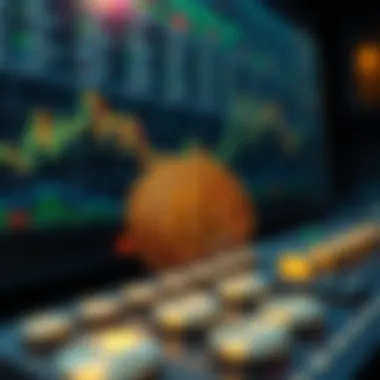Understanding Margin on Futures Trading Strategies


Intro
Diving into the world of futures trading may feel like stepping into a high-stakes chess match. Each decision, every move, holds weight. One of the most crucial elements to grasp in this arena is margin. Whether you’re an investor, a seasoned trader, or just a tech-savvy individual navigating these tumultuous waters, understanding margin is not just beneficial; it's essential.
Margin in the context of futures trading refers to the minimum amount of capital that must be available to open and maintain a leveraged position. It acts as a financial buffer, allowing traders to manage risk while increasing their potential for profit. But, it also comes with its own set of intricacies and potential pitfalls.
In this guide, we will break down margin—looking closely at its significance, the different types, as well as the regulatory perspectives that shape how it operates. Readers will also encounter best practices for managing margin effectively, especially amidst the volatility synonymous with the futures markets.
Understanding Cryptocurrency Market Trends
This might seem a bit tangential at first glance, but cryptocurrency market trends play a significant role in the broader discussion around margins. Particularly for those trading futures tied to crypto-assets, the landscape can shift faster than the blink of an eye.
Current Market Analysis
The current state of the cryptocurrency market is defined by rapid fluctuations and unpredictable trading behavior. Investors and traders must keep a keen eye on shifting trends. For instance, Bitcoin and Ethereum have shown profound volatility in recent months, causing margin requirements to change almost overnight.
Monitoring price trends, trading volumes, and even macroeconomic factors such as interest rates can provide valuable insight. Utilizing tools such as technical analysis and sentiment indicators can help traders make informed decisions under these ever-changing conditions.
Historical Performance and Lessons Learned
Reflecting on historical performance can provide a reliable compass for navigating future investments. The rise and steady fall of major coins often reveal patterns that can inform trading strategies when dealing with margin.
- Price Patterns: Recognizing bullish and bearish phases could suggest appropriate times for margin trading. For instance, if volatility predictions lean positive during earnings announcements or market news, this could warrant a more aggressive margin stance.
- Regulatory Shifts: Various countries have altered their regulatory environments concerning cryptocurrency, which has impacted margin trading. The more traders understand these fluctuations, the better prepared they’ll be for the next big move.
As seen from the past, margin trading requires both strategy and caution. Only through vigilant observation can one prepare for the possibilities that lie ahead.
"In the poker of futures trading, margin is both your stack and your bluff. Master it to win the game."
Practical Guides for Crypto Investors
In the tumultuous world of crypto-trading, having a clear set of strategies can give traders an edge. Below are some practical approaches tailored specifically for navigating margins in futures markets.
Step-by-Step Trading Strategies
- Understand Your Risk Tolerance: Before engaging with futures, assess how much risk you can tolerate. Different levels of investment require various strategies when approaching margin.
- Choose a Trusted Futures Broker: Selecting a broker that understands the crypto landscape can help guide your trading. Make sure they offer a transparent fee structure.
- Monitor Your Margin Levels: Staying aware of your margin requirements helps in managing your positions effectively. This could mean avoiding over-leveraging when conditions appear unstable.
- Develop a Trading Plan: Clearly outline your strategy, including entry and exit points. Stick to the plan unless conditions signify a clear requirement for re-evaluation.
Risk Management Techniques
- Diversify Your Portfolio: Avoid putting all your eggs in one basket. Spread your investments across different futures to balance risk.
- Use Stop-Loss Orders: This technique is pivotal in margin trading to minimize losses. Setting a stop-loss order can help automatically close your position if it starts to move against you.
- Regular Review and Adjustment: Amid the fast-moving trends, regularly reviewing your strategies and portfolios helps ensure they remain optimal.
Every step taken toward a profound understanding of margin can empower traders to navigate the choppy waters of futures trading more competently. Knowing how to handle margin can ultimately be your ace in the hole.
Helpful resources include Investopedia, CME Group, and NFA. Readers are encouraged to utilize various tools and platforms to stay informed and enhance their trading outcomes.
Prologue to Futures Trading
Futures trading occupies a significant space in the world of finance, serving as a versatile tool for both investors and traders alike. At its core, this trading form allows participants to speculate on the future price of assets like commodities, currencies, and financial instruments without needing to own the underlying asset outright. Understanding the mechanics of futures trading is crucial, as it lays the foundation for grasping more advanced concepts such as margin and leverage.
Investors looking to hedge against market fluctuations often turn to futures contracts, providing a safety net for their investments. This allows them to lock in prices, reducing the uncertainty often associated with market volatility. Likewise, traders looking to profit from price movements can use futures to multiply their potential returns — albeit while embracing the accompanying risks. This dual benefit is a primary reason why futures trading has garnered significant attention over the years.
Definition of Futures Contracts
A futures contract is a legally binding agreement between two parties to buy or sell an asset at a predetermined price at a specified future date. The contracts are standardized, traded on exchanges, and cover a wide array of commodities and financial instruments. This means that both parties know exactly what they are agreeing to, which fosters transparency in the transaction.
Key characteristics of futures contracts include:
- Standardization: Each contract specifies the quantity, quality, and delivery details regarding the underlying asset.
- Obligation: Unlike options, futures obligate the holder to fulfill the contract at expiration, whether by buying or selling.
- Leverage: Futures trading often involves margin, allowing traders to control larger positions with smaller sums of capital.
The mechanics of these contracts allow for various strategic approaches — from hedging to speculation — yet also necessitate a solid understanding of the risks involved.
History of Futures Markets
Futures markets have roots tracing back thousands of years. The concept began with farmers and traders negotiating prices for crops before harvest to cushion against fluctuating market prices. With the advent of more sophisticated financial systems, these informal agreements evolved.
- In the 19th century, organized futures exchanges emerged, beginning in Chicago with the Chicago Board of Trade. The transition to a formalized market structure allowed for improved liquidity and risk management.
- Technological advancements in the 20th century saw futures trading shift to electronic platforms, paving the way for global participation and an explosion in trading volume.
As these markets continue to grow, the underlying principles remain tied to their agricultural beginnings, with the focus on price stabilization for producers and speculators alike. This enduring relevance underscores the importance of futures contracts in today’s financial landscape.
The Concept of Margin in Futures
Understanding the role of margin in futures trading is essential for anyone who wishes to navigate this complex financial landscape. Margin acts as a financial reservoir, shaping the way traders approach their positions and manage their risks. Without a clear grasp of this concept, one might be sailing blind amidst turbulent market waters.
What is Margin?
Margin refers to the amount of money a trader must deposit with a broker to open and maintain a futures position. It is not a fee or a cost but rather a security deposit intended to cover potential losses in the trading account. To paint a clearer picture, think of it as putting down an earnest payment when renting an apartment. You’re not handing over the full price upfront, but it secures your right to live there while mitigating the landlord's risk.


In the realm of futures, there are generally two types of margin: initial margin and maintenance margin. The initial margin is what you need to put forth when you first enter into a contract, while the maintenance margin is the minimum account balance you must hold to keep your position open, ensuring that the broker is covered if things go sideways.
"Margin is the lifeline of futures trading; without it, you could find yourself at the mercy of the market's whims."
Importance of Margin in Futures Trading
The importance of margin in futures trading cannot be overstated. It provides a layer of leverage, allowing traders to control large positions with a relatively small amount of capital. This can be beneficial, especially in markets that fluctuate rapidly. However, with great power comes great responsibility. Here are a few specific benefits and considerations regarding margin in futures trading:
- Leverage: Margin enables traders to amplify their profits potential. For instance, if a trader has a $5,000 margin account and utilizes a margin of 10%, they can control a futures contract valued at $50,000. However, it’s important to remember that while leverage can boost gains, it can equally magnify losses.
- Capital Efficiency: Traders can free up capital by using margin, investing in multiple positions without needing to have full cash reserves for each trade. This capital efficiency can lead to more aggressive trading strategies.
- Market Participation: Margin makes it feasible for smaller traders to participate in the futures market where outright purchases would be prohibitively expensive. This accessibility can forge a more dynamic trading environment, increasing liquidity.
On the flip side, it is crucial to consider the risks associated with margin. A volatile market can lead to sudden margin calls, where a broker demands additional funds. Failing to meet this demand could result in the closure of your positions at a loss, a scenario that can be detrimental to both novice and seasoned traders. In addition:
- Risk Exposure: Because margin amplifies both profits and losses, the potential for significant financial loss is heightened. Traders must have a clear risk management strategy in place to mitigate these risks effectively.
- Psychological Factors: Trading on margin can introduce psychological stress, leading traders to make impulsive decisions rather than following a well-thought-out strategy.
In essence, the concept of margin in futures trading is a double-edged sword. It can facilitate greater access and potential profits but comes with increased risk and responsibility. A deep understanding of how margin works is crucial for anyone looking to thrive in the fast-paced world of futures.
Types of Margins in Futures Trading
In the realm of futures trading, margins play a crucial role. Understanding the types of margins can significantly enhance a trader’s ability to manage risk and leverage capital effectively. Not only does a solid grasp of these concepts help in making informed decisions, but it also allows traders to navigate the complexities of the market with a clearer vision. The intricacies of margin requirements can be the difference between substantial gains and costly mistakes. Let’s break down the key types of margins that traders encounter and the considerations tied to each.
Initial Margin Explained
The initial margin represents the upfront capital that a trader must put down to open a position in futures trading. This is akin to a security deposit; it assures the broker that the trader can cover potential losses. The amount can vary from one contract to another and is usually set by the exchanges and brokers. When a trader opens a position, they are required to have this initial margin in their account, demonstrating their commitment and capacity to handle the volatility of the futures market.
One essential aspect of initial margin to keep in mind is its fluctuation. Depending on market conditions, the exchanges may adjust these requirements. For instance, during times of high volatility, such as significant financial news or earnings reports, initial margin levels might increase. Traders should stay updated on these changes since they can necessitate additional funds in the account.
Maintenance Margin Overview
Once a position is established, the maintenance margin comes into play. This is the minimum amount of equity that must remain in the trading account to keep a futures position open. If the account value dips below this threshold due to adverse price movements, a margin call is likely to occur. A margin call is a broker's demand for additional funds to replenish the account balance.
In practice, maintaining the required margin is like walking a tightrope; a balance must be struck between risk and capital. Failing to meet maintenance margin requirements can lead to forced liquidations, where the broker closes positions to protect against further losses. Traders should monitor their accounts diligently, as sudden market shifts can swiftly erode equity.
Variation Margin Clarified
Lastly, the variation margin refers to the additional funds that must be deposited or can be withdrawn based on daily market movements. Essentially, it accounts for the profit or loss from changes in market value during a trading session. Every day, futures contracts are marked to market, which means that gains and losses are settled at the end of the trading day. This mechanism ensures that both the investor and broker are shielded from accumulating excessive risk.
Variation margin is crucial for traders who leverage their positions. For instance, if the market turns against a trader's position, they may be required to add variation margin to maintain their account's equity. Conversely, if they’re in the green, they may receive funds back, which can be a boon for reinvestment in new trades. Thus, variation margin reinforces the importance of astute market monitoring.
Understanding the dynamics of initial, maintenance, and variation margins is not just an academic exercise; it’s a necessity for active futures traders looking to protect their investments and optimize their trading strategies.
In summary, differentiating between these types of margins empowers traders with the knowledge to execute strategies that align with their risk tolerance. Whether you’re an aspiring trader or a seasoned investor, honing your understanding of margin will serve you well in futures trading, surely enhancing your overall trading experience and success.
Calculating Margin Requirements
Calculating margin requirements is a crucial aspect of futures trading that directly influences a trader's ability to engage in various market opportunities. The process involves a thorough understanding of the interplay between the market's volatility, one's trading strategy, and the available capital. By accurately calculating margin requirements, traders can better manage risk, ensuring they don’t land in murky waters when the market takes an unexpected turn.
Not only does this calculation determine how much capital is needed to open a position, but it also dictates how much risk one can tolerate without incurring substantial losses. Thus, understanding the mechanics behind margin calculations can significantly affect trading outcomes and liquidity management. It paves the way for informed decision-making, enabling traders to navigate the complex waters of futures markets more confidently.
Factors such as contract specifications, market conditions, and volatility significantly shape these requirements. Being aware of who’s in charge of these calculations, such as exchanges and brokers, is fundamental as well, ensuring that traders are prepared and resistant to market fluctuations.
Moreover, insights into margin calculations empower traders to strategize better. Making data-driven decisions can distinguish between a prudent trader and one swimming with the sharks.
"Understanding the calculation of margin is akin to knowing the compass in the unpredictable seas of futures trading—navigate with precision, and you stand a better chance of reaching your destination."
Factors Influencing Margin Calculation
Margin calculations do not exist in a vacuum; they’re influenced by many elements that traders must assess diligently. One key factor is the underlying asset's volatility. For instance, if an asset has experienced sharp price swings in recent times, a broker may increase the margin requirement to buffer against potential losses. This higher threshold acts as a safety net, helping manage the increased risk of substantial price movements.
Other elements affecting margin calculations include:
- Contract Size: Futures contracts vary in size, and larger contracts typically require higher margin to cover potential losses.
- Market Conditions: Changing economic indicators, geopolitical events, and market sentiment can lead to fluctuations in margin requirements across different sectors.
- Leverage: The degree of leverage one employs in trading can dramatically affect margin. High leverage means higher potential profits, but it also increases margin risks significantly.
Such dynamic interactions mean that traders must stay alert and adaptive. By comprehensively understanding these factors, traders can tailor their strategies effectively, positioning themselves to make sound trading decisions.
Using Margin Calculators
Margin calculators are invaluable tools for traders seeking to streamline the process of calculating their required margins. With the rapid pace of trading and the prevalence of online platforms, leveraging a margin calculator can give traders a reliable foundation for understanding their capital needs.
Most margin calculators operate on standard formulas that incorporate essential inputs, including:
- Account Type: Different accounts might have distinct margin requirements depending on regulations and brokerage rules.
- Position Size: Higher position sizes necessitate larger margins due to the increased risk exposure.
- Leverage Ratio: This ratio determines how much capital is needed relative to the position size, crucial in maintaining healthy margins.
Using these calculators can make traders feel like they’ve got a big bright green light guiding them. Knowledge fosters confidence, equipping them with the necessary tools to face the uncertain tides of trading.
While margin calculators simplify the process, traders should also double-check their outputs with industry standards. If uncertainties linger, seeking assistance from a seasoned trading professional can ensure that all calculations align with best practices, laying the groundwork for a more stable trading journey.


Regulatory Considerations
Navigating the landscape of futures trading is not just an exercise in strategy; it's also a complex dance with regulations that ensure market integrity and protect traders. Understanding regulatory considerations is crucial for anyone involved in futures trading. Regulatory frameworks play a pivotal role in establishing the rules of engagement and ensuring that all participants play fair. Additionally, compliance with these regulations can be the difference between a flourishing trading operation and catastrophic financial loss.
When we talk about regulatory considerations in futures trading, several key elements come into play:
- Market Integrity: Regulations are put in place to protect the markets from manipulation, fraud, and abuse. This is fundamental for maintaining investor confidence.
- Transparency: Regulatory bodies require that all transactions be recorded and reported, paving the way for transparency. CLear reporting helps in assessing market activity, which can in turn influence one's trading strategy.
- Risk Management: Regulations often enforce certain risk management protocols that traders must adhere to, which can help mitigate potential losses in volatile market conditions.
"Regulations in the financial markets serve as the rules of the game, ensuring that no one’s playing dirty."
Understanding Regulatory Frameworks
The regulatory landscape for futures trading is akin to a maze, with various bodies overseeing different aspects. In the U.S., the Commodity Futures Trading Commission (CFTC) and the National Futures Association (NFA) are at the forefront. They establish rules that govern trading practices, which helps maintain fair and orderly markets.
Regulatory frameworks differ by country but generally cover several common areas:
- Licensing of Exchanges and Brokers: Traders must only operate through exchanges and brokers that are licensed and regulated by the appropriate bodies. This acts as a safeguard for traders.
- Reporting Standards: Various regulations mandate that trading activity be reported to ensure that all market participants are abiding by the rules. Failure to comply can lead to severe penalties.
- Compliance Audits: Regulatory bodies conduct regular audits to ensure compliance with the established rules. These audits can impact a broker’s reputation and operational capability.
Understanding this framework enables traders to navigate futures markets with greater confidence, ensuring they are not inadvertently stepping outside the bounds of legality.
Impact of Regulations on Margin Trading
The impact of regulations on margin trading cannot be overstated. These regulations dictate how much margin must be maintained and under what circumstances margin calls may be invoked.
- Initial and Maintenance Margins: Regulatory requirements help define the minimum amount a trader must deposit to open a position and the ongoing amount that must be maintained. These safeguards prevent excessive risk-taking that could lead to market instability.
- Margin Calls: Regulations determine the circumstances and processes under which margin calls occur. Traders must be aware that if their account value drops below a certain threshold, they will need to promptly restore their account balance, often resulting in forced sales of positions at unfavorable prices.
- Leverage Limits: Regulatory bodies might set strict limits on leverage that can be used, thereby helping to control the overall risk associated with trading on margin.
In summary, regulations in margin trading not only outline what is permissible but also serve an essential role in mitigating the sorts of risks that can lead to market chaos. Investing the time to understand these regulations will pay dividends in the long run, as it equips traders with knowledge to protect their investments.
Risks Associated with Margin Trading
Margin trading can be a double-edged sword, leading to potentially significant rewards along with considerable risks. The allure of high returns tempts investors and traders alike to delve into the world of margin. However, it’s paramount to grasp the nuances of those inherent risks to navigate successfully in this space. Not only does understanding these risks help in decision-making, but it also fortifies one’s strategic frameworks in futures trading. In this section, we dissect the risks associated with margin trading, highlighting key aspects and considerations.
Identifying the Risks of Leverage
Leverage is a fundamental concept in margin trading, allowing investors to control a larger position than their capital would typically permit. This can amplify gains. For instance, if you invest $5,000 on a $50,000 position with a 10:1 leverage, you're enjoying a significant exposure to the market. However, a misstep could also magnify losses, potentially wiping out your initial investment and even plunging you into debt.
Some risks associated with leverage include:
- Increased Loss Potential: A small shift in market price can lead to sizeable percent losses in your capital, as your investment's overall risk is much larger than the funds you originally put in.
- Market Volatility: Futures markets can be erratic, influenced by various external factors such as economic announcements, geopolitical events, and unexpected shifts in supply and demand. Volatility increases the likelihood of facing losses.
- Emotional Decision Making: The thrill associated with potential gains and the fear of losses can cloud judgment, leading to hasty decisions that deviate from well-crafted strategies.
Awareness of these risks is crucial for every trader aiming to utilize leverage responsibly. Every strategic action should account not only for possible gains but also for the loss exposure that comes with each trade.
Margin Calls: What to Expect
Margin calls represent a critical juncture for traders involved in margin trading. Essentially, a margin call occurs when the equity in a trading account falls below the maintenance margin requirement imposed by the broker. This could be a frightening scenario, as it indicates that your position has decreased significantly, requiring immediate action to avoid further losses.
When you receive a margin call, you should anticipate the following steps:
- Notification: Your broker will inform you that your equity has dipped below the required level. This could happen through email, text, or a call.
- Options for Response: You will typically have a few options:
- Time Sensitivity: It’s essential to respond to a margin call swiftly, as brokers often impose strict deadlines to rectify the situation. Delay can lead to automatic liquidation of your assets, which may happen at unfavorable market conditions.
- Deposit More Funds: Infusing your account with additional capital can help meet margin requirements and keep your positions intact.
- Close Positions: If you're unable or unwilling to add funds, you might need to close out some of your positions to restore the equity level.
- Combination of Both: In some situations, a trader might choose to deposit more funds while also closing some positions, balancing risk management and liquidity needs.
The key to managing margin calls lies in proactive risk management, ensuring that your trading strategy considers potential market fluctuations and sets aside adequate funds to meet margin requirements without undue stress.
For further insights into the features of margin trading, the U.S. Securities and Exchange Commission and Investopedia provide substantial resources on these topics.
Best Practices for Margin Trading
Understanding the nuances of margin trading is crucial for anyone looking to navigate the intricate world of futures trading. To ensure success while minimizing potential pitfalls, adopting best practices can make a world of difference. This section discusses these practices and their importance in establishing a robust trading approach.
Developing a Margin Strategy
Crafting a solid margin strategy is akin to laying a strong foundation before construction—without it, you might quickly find yourself, hopefully not, buried under your own ambitions. Initially, one needs to assess their financial capacity and risk tolerance. It’s imperative to establish a clear plan before engaging in trading, considering factors such as the size of the trade, market volatility, and, importantly, the purpose of utilizing margin.
For instance, determine if you are aiming for short-term gains or long-term investments. Tailoring your strategy to match your goals can help mitigate risks associated with margin trading. Here are a few considerations when developing your margin strategy:
- Risk Assessment: Evaluate how much risk you are willing to take and the potential impact on your overall portfolio.
- Position Sizing: Decide how much capital you wish to allocate to each position, ensuring you maintain adequate reserves for margin requirements.
- Market Analysis: Stay informed on market trends and events that may influence your positions. Knowledge of underlying factors can help make more informed decisions.
As you set your strategies, remember what they say: "Failing to prepare is preparing to fail." To weather unforeseen market conditions, be flexible and ready to adjust your tactics as needed.
Implementing Risk Management Techniques
Once your strategy is in place, it’s essential to devise effective risk management techniques. Margin trading, while alluring due to its potential for higher profits, can also amplify losses, catching traders off guard if they're not adequately prepared.
One of the primary techniques is employing stop-loss orders. These orders can help limit losses by automatically selling a position when it reaches a predetermined price. Another tactic is diversifying your portfolio; don’t have all your eggs in one basket. By spreading your investments across various assets, you can cushion against volatility in any single market.


Consider these risk management approaches:
- Use of Stop-Loss Orders: Set these orders to control potential losses and protect your margins.
- Leverage Control: Limit the amount of leverage used to prevent excessive exposure.
- Constant Monitoring: Keep an eye on market trends and your positions. Using real-time analytics can help identify when to cut losses or take profits.
"An ounce of prevention is worth a pound of cure."
Regular review and revisions based on performance can help fortify your trading approach. Incorporating trading journals to document decisions and their results also enables learning from past mistakes, enhancing your future strategies.
By implementing these best practices, you’re not just playing the game but getting well acquainted with its rules, significantly enhancing your chances for a rewarding trading experience.
Comparison with Other Trading Instruments
In the realm of trading, understanding the principles of margin becomes a crucial aspect when comparing different instruments like futures, forex, and stocks. The tine difference in how margin is utilized can determine the efficiency of trading strategies and potential profitability. This section aims to shed light on these distinctions, illuminating benefits as well as considerations that traders should account for while navigating their options.
Margin in Forex Trading
Forex, or foreign exchange trading, is known for its high leverage levels. Here, traders can control significant amounts of capital with relatively small deposits. The margin in forex is typically presented as a percentage, indicating how much of the total trade value must be set aside as collateral. Standard leverage ratios often range from 50:1 to 500:1.
This extended leverage could be a double-edged sword. On one hand, traders can amplify their returns significantly. On the other hand, it requires a sophisticated understanding of market movements along with robust risk management techniques. Since the forex market is highly liquid, it allows for fast execution of trades but also increases the chances of abrupt price shifts.
- Benefits of Margin in Forex:
- Enhanced buying power
- Flexibility in trading strategy
- Quick accessibility to various currency pairs
However, the pitfalls can’t be overlooked. Market volatility can lead to swift losses, requiring traders to remain vigilant and responsive. Let’s consider a trader who uses 100:1 leverage to purchase $100,000 worth of currency. This trader would need to deposit only $1,000, but even a minor fluctuation could result in significant gains or losses.
Margin in Stock Trading
Shifting gears to stock trading, margin operates under a different narrative. Here, investors can borrow funds from brokerage firms to purchase additional stocks. Similar to the forex market, a margin requirement is established; typically, it ranges from 25% to 50% for most stocks. This variances adds a layer to the trading experience. Investors are required to maintain a minimum balance (known as the maintenance margin) or face a potential margin call.
- Benefits of Margin in Stock Trading:
- Ability to amplify purchasing power
- Potential for higher returns on investment
- Opportunity to diversify portfolio with leveraged funds
However, in stock trading, margin comes with greater regulatory governance. Margin calls can occur, forcing investors to deposit additional funds or liquidate their positions. The ability to sustain trades during market contractions is essential, as the equity value can change rapidly.
Ultimately, margin on non-futures trading instruments might offer varying degrees of leverage and risk, requiring traders to balance ambition with awareness of their limits.
For further readings on these topics, you might explore resources like Investopedia for deeper insights into trading mechanics, or Wikipedia for a broader contextual understanding.
Future Trends in Margin Trading
The landscape of margin trading in futures is continuously evolving, influenced by a wave of technological innovations and shifts in market behavior. As trading practices adapt, understanding these future trends helps investors and traders stay ahead of the curve. The implications for margin strategies are profound, especially as they relate to risk management and liquidity.
Technological Advancements
In today’s fast-paced trading environment, technology plays a central role in shaping margin trading dynamics. The integration of artificial intelligence and machine learning stands out as a game changer. These technologies not only enhance predictive analytics but also improve risk assessment strategies. For instance, trading software now utilizes real-time data to adjust margin requirements based on market volatility and trader behavior, ensuring that risks are managed more effectively.
Moreover, cloud computing facilitates the easy access and processing of vast data sets, which aids traders in making informed decisions. With platforms like MetaTrader, traders can simulate different margin scenarios to understand potential outcomes before committing capital. This kind of foresight can be critical, allowing for more calculated risk-taking.
Other advancements, such as blockchain technology, offer prospects for increased transparency and security in margin trading. Smart contracts can automatically adjust margin requirements and execute trades, lowering the risk of human error and potentially expediting the execution process.
"Innovation in trading technology is no longer optional; it’s essential for survival and success in margin trading."
Changing Market Dynamics
The futures market is becoming increasingly interconnected, influenced by various factors such as geopolitical events, economic indicators, and market sentiment. These external elements can cause abrupt changes in margin requirements and risk profiles. Traders need to adapt to these dynamics swiftly. For example, a sudden rise in crude oil prices due to geopolitical unrest can lead to increased volatility, prompting brokers to raise margin levels to protect themselves.
Additionally, new entrants, such as retail traders facilitated by online platforms, change the market landscape. Their participation increases volume, but it also adds unpredictability to price movements, which can impact margin calculations. With more players in the game, behavioral trends itself shifts, leading to possibly eradicating previous patterns.
End
Wrapping up our discourse, the significance of margin constraints in futures trading cannot be overstated. Understanding this facet is critical for any practitioner in the financial markets. First, it acts as both a shield and a sword; on one hand, it provides access to larger positions without upfront capital, yet on the other, it increases the risk exposure if the market turns against your position.
Recap of Key Points
To distill the essential aspects we covered:
- Definition of Margin: We defined margin as a good faith deposit to secure a futures contract, which is crucial for both the trader and the exchange.
- Types of Margins: We broke down the various margins like initial, maintenance, and variation, examining how they function at different levels of trading.
- Risks and Strategies: The risks tied to margin trading, including margin calls and leverage risks, require prudent risk management strategies to ensure a trader’s longevity in the market.
In light of these points, it becomes clear that margin is a double-edged sword in futures trading.
Looking Forward in Futures Trading
As we look ahead, several trends are poised to shape the future of margin trading. Technological advancements are ushering in new tools and methods that promise to enhance risk assessment and improve decision-making. Better analytics could streamline how traders deal with margin requirements and their inherent risks.
Moreover, as market dynamics shift, regulatory frameworks are likely to evolve, further influencing how margin is utilized. It's imperative for investors and traders to stay abreast of these developments to navigate this complex landscape effectively.
Ultimately, a solid understanding of margin not only bolsters risk management but also informs strategic decisions, making it an invaluable tool in the arsenal of any futures trader.
"In the world of finance, knowledge is power, but understanding margin can be your lifeline."
For those interested in diving deeper into the subject matter, resources such as Investopedia and CME Group provide insightful analyses and updates.















